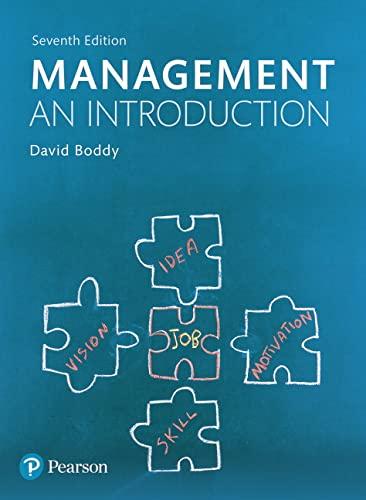Question
Umiker's Management Skill for the New Health Care Supervisor Seventh Edition What are the differences between the power of personality and the power conferred by
Umiker's Management Skill for the New Health Care Supervisor Seventh Edition
What are the differences between the power of personality and the power conferred by positional authority? And does the successful supervisor need one or the other or both? Chapter 21
Based on the Case: The Blindside, answer the following questions: A. Do you believe there is anything George can do about Charlie's staff meeting behavior? If so, how should he proceed? B. Do you believe George should take up his concerns directly with Charlie? Why, or why not? Chapter 21
Provide one example of potential quid pro quo sexual harassment and one example of hostile environment sexual harassment. Chapter 22
What is the potential hazard in a consensual intimate relationship between two employees? Between an employee and supervisor? Chapter 22
Chapter 33 suggests how autocratic, consultative, and participative managers make decisions. How are bureaucratic managers likely to make decisions?
In diagnosing a problem, it is always necessary to be on guard against mistakenly labeling a problem symptom as the problem itself. What is most likely to happen if what is addressed is a problem symptom and not the causal problem? Chapter 33
Based on the Case: The Long-Time Employee, chapter 33 answer the following questions: A. It is evident that you need to make a decision concerning Hilda and her apparent inability to keep up with the work. Identify at least three alternatives (or more, if you wish) that you believe might be possible. B. Which alternative appears sufficiently workable to be the first one attempted? And what information do you need to assemble in preparing to justify your decision C. If your initial decision is found unworkable or unacceptable, which alternative would be your second choice? Why?
What is the strongest force acting to prevent us from improving our use of time? Why is this and what can be done about it? Chapter 34
What particular characteristics might be exhibited by a supervisor who continually seems to become caught up in people problems that should actually be addressed by others? Chapter 34
Based on the Case: Where does the time go?, Chapter 34 answer the following questions: A. What apparent mistakes did Kay make in attempting to improve her use of time by planning and establishing priorities? B. In what respects could Kay possibly have improved her use of time on the Monday described in the case? (State any reasonable assumptions you might make in providing possible answers.)
How has the recent years' trend toward reengineering, reorganizing, and the formation of health systems contributed to employee stress? To management stress? Chapter 35
Based on the Case: The Forceful Organize, answer the following questions: A. It seems obvious to you that the building service worker is caught in a stressful situation. What can you do to provide the employee with some immediate relief? B. The individual who is "cornered" is not one of your employees. What do you believe is your responsibility, if any, to this employee? C. What will you do if you recognize the man as an employee (of a department other than yours)? Or if you are reasonably certain he is an outsider? D. What would you recommend as steps to take to reduce the chances of other employee being subjected to the same behavior?
Step by Step Solution
There are 3 Steps involved in it
Step: 1

Get Instant Access to Expert-Tailored Solutions
See step-by-step solutions with expert insights and AI powered tools for academic success
Step: 2

Step: 3

Ace Your Homework with AI
Get the answers you need in no time with our AI-driven, step-by-step assistance
Get Started


